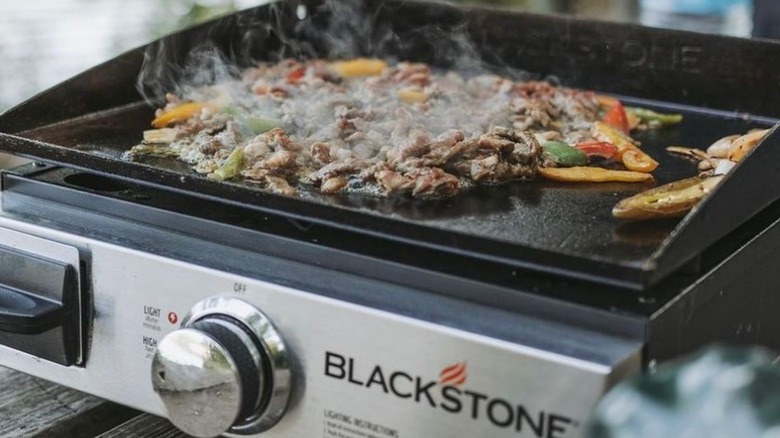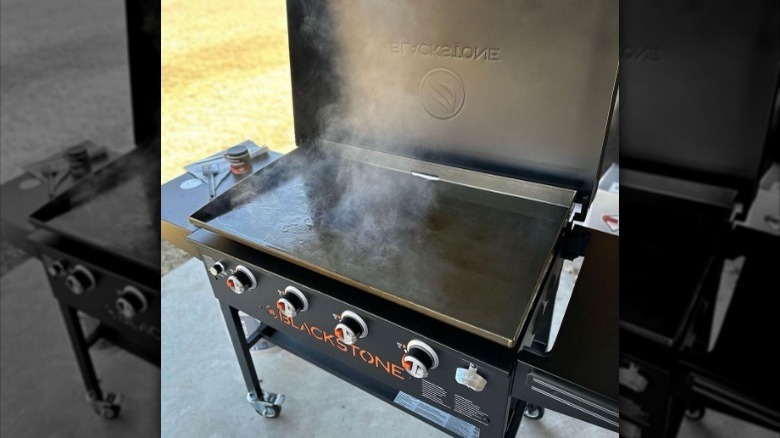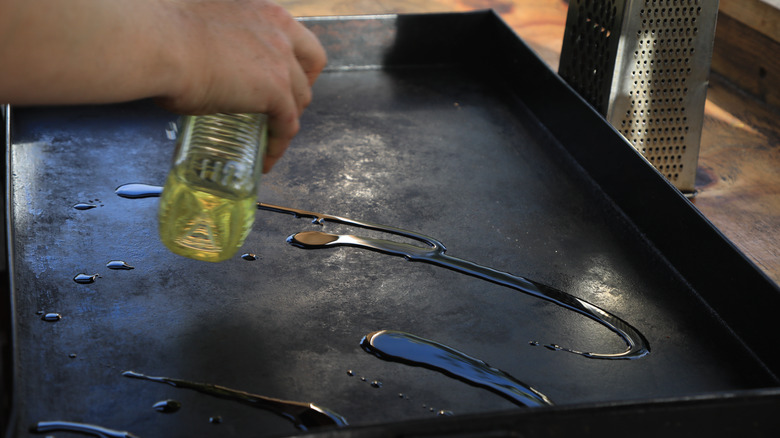How To Clean A Blackstone Griddle And How Often You Should Do It
Outdoor griddles can cook just about anything. Unlike traditional grills, which feature grates, griddles have a flat, smooth cooking surface, meaning you can easily whip up a pizza, perfect pancakes, batches of scrambled eggs, or stir-fry — the tasty options are endless. Moreover, they have precise temperature controls so your food comes out just right every time. But, when it comes to griddles, the brand Blackstone tops the list. The high-quality and incredibly versatile appliances make outdoor cooking a breeze. Not to mention, their non-stick surface and patented rear grease management system make cleaning them quick and easy too — so long as you use the proper technique: cleaning the cooker with a good scrubber and a little hot water after every use.
Just like their barbecue counterparts, outdoor griddles are prone to tough, burnt-on residue, and Blackstone's products are no different. Their cooking surfaces are made from steel, which features a combination of iron and carbon, and thus they easily tarnish. When they're dirty, they can absorb moisture, which can cause cracks and rust to form. In order to prevent costly repairs and extend the longevity of your outdoor appliance, it's important to clean them regularly — pretty much after each use — so your cooker always looks brand-new.
Scrub your griddle with hot water
Getting the gunk off of a Blackstone cooking machine is easy: All you need are paper towels, a metal spatula, a scouring pad, cooking oil, hot water, and a little elbow grease. In order to prevent any burns, you always want to make sure your appliance has completely cooled down before scrubbing. After it's cool to the touch, use a metal spatula to gently scrape away any leftover food remnants, ensuring you don't scratch the surface, and then wipe the surface down with paper towels. If there's any remaining stuck-on food or grease, simply pour some hot water onto the griddle and use the scouring pad to scrub away the grime. Wipe the water away with more paper towels and then use a clean rag or dishtowel to thoroughly dry it.
It's important to note that Blackstone warns against using soap because it can leave behind soap residue and strip the crucial seasoning layer off. Although you may be tempted to douse the griddle top with soapy water, you should only use a clear cleaning detergent sparingly the very first time you clean your griddle. In this case, you can mix together a simple cleaning solution of hot water and a few squirts of dishwashing liquid in a bucket and use a towel or brush to scrub the cooking surface. Wipe down the griddle with water and then give it a good towel dry — and don't forget to give it a good seasoning, too.
Always season your griddle after cleaning
Cleaning your griddle regularly is essential. However, when it comes to extending the life of your outdoor appliance, seasoning it after each scrub down is just as important. Seasoning the griddle with oil helps to create a non-stick surface so your food doesn't stick to the griddle, making flipping even easier. But, perhaps even more importantly, the thin coating of oil acts as a protective layer, keeping water at bay to help prevent rust.
To season the griddle, simply spread a few tablespoons of cooking oil, such as canola or olive oil, onto the cooking surface using a paper towel. (Be sure not to use too much oil, which can leave a sticky residue on the flat top.) Turn the temperature on high and allow the oil to cook for about 10 to 15 minutes until it stops smoking. Repeat the process about two to three times until the surface is black, and you're ready to get cooking.



